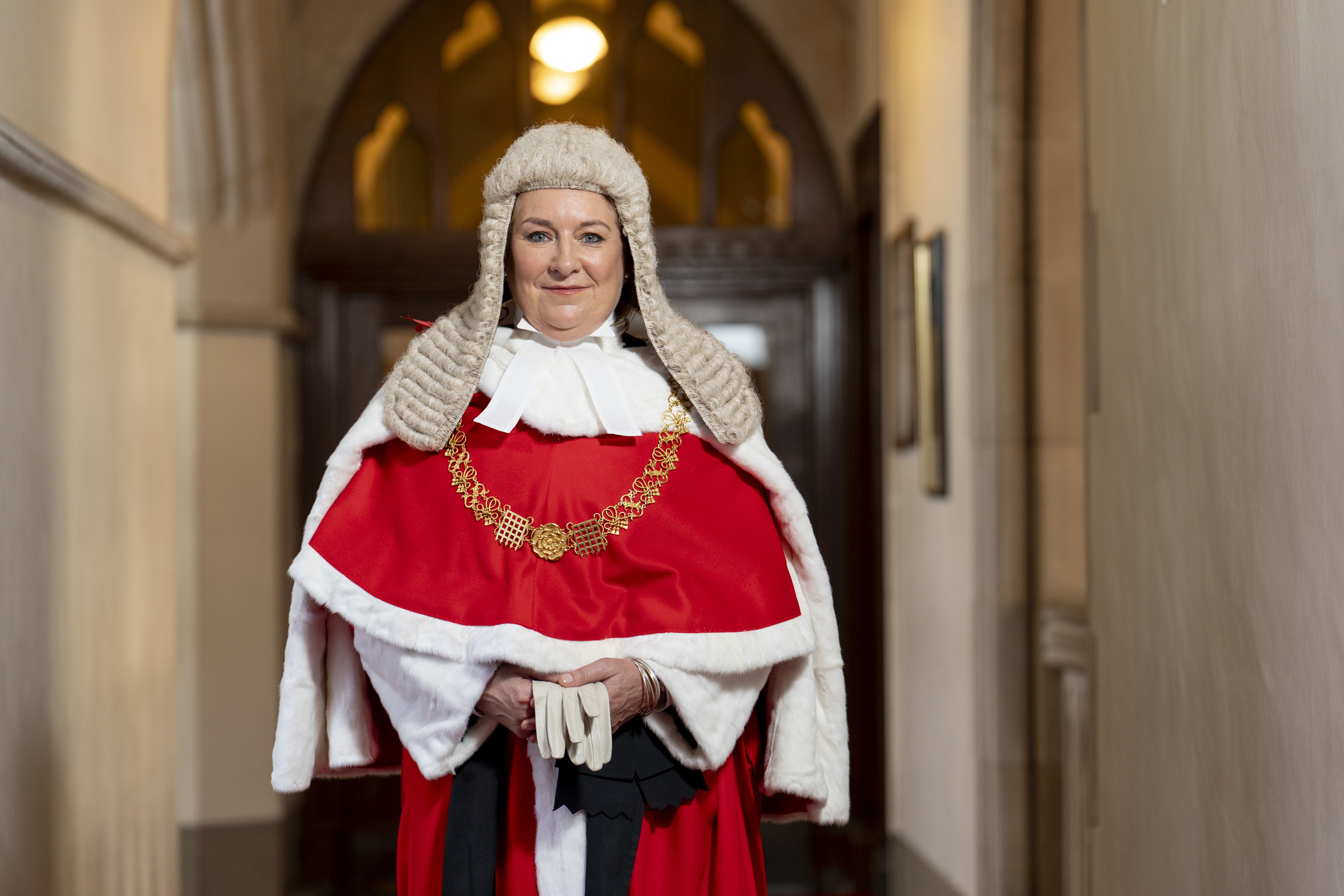What on earth is her ladyship wearing? The sartorial shambles of Britain’s formal garb
Whoever designed the first lady chief justice’s coming-out ensemble needs to go back to the drawing board, writes Mary Dejevsky


Now, I could not be more delighted at the fall of another male bastion, with the arrival of Dame Sue Carr as the most senior judge in England and Wales. But I must admit that when I saw the pictures of the lady chief justice, as per her formal title, alongside the justice secretary, Alex Chalk, my first thought was not of the landmark achievement for women, but of the sartorial shambles on display.
Just look at the pair of them as they left Westminster Abbey after the annual service that marks the start of the legal year.
Take the justice secretary first, in his lord chancellor’s get-up. The robe, with its brocade decoration, is fine, but far too short for his height – he would seem to be quite a tall guy – and his wig sits strangely. Did he look in a full-length mirror before he set off? Might he perhaps need a valet to check his camera-readiness before public appearances?
But, dear oh dear, what on earth is her ladyship wearing?
A basic difficulty here may well be that those who arrange such things may never have thought about how ceremonial attire that was prescribed for decades – nay, centuries – for men can be adapted for women. But I doubt whether any self-respecting French or Italian woman would have stepped out in this lumpy apology for an outfit after one glance in the mirror.
She looks like a cross between Santa Claus and an ill-dressed bishop. Her chain of office sits awkwardly over an unflatteringly short fur cape; there’s a complicated high collar arrangement, and her wig does her no favours either. Maybe each element has some historic significance, but the whole impression is of poorly coordinated fussiness. Is this really the best that the UK, with its attachment to pageantry and a tradition of high-class tailoring, can do?
One route might be the Penny Mordaunt solution – if there is no precedent or you don’t like what is on offer, design your own, which is reportedly what she did earlier this year when she devised a fusion of ancient and modern dress to bear the sword at the Coronation.
Another might be to ditch the least satisfactory elements, but adapt the rest. When elected the first female speaker of the House of Commons, Betty Boothroyd ditched the wig, replaced the breeches with a skirt, and adapted the robe – a simple black gown akin to that of a university professor for daily wear – with a heavy black and gold version for special occasions.
Her innovations have stuck. None of her (male) successors have gone back to wearing a wig. The first female Black Rod might have been well advised to follow where the late Baroness Boothroyd led. Yes, she abandoned the wig, but Sarah Clarke can be seen strutting her stuff in breeches and a coat that is just the wrong length, and a gold chain of office sitting as uncomfortably across her elaborate lace bib as the lady chief justice’s across her cape.
You might ask whether, in this age of informality, ceremonial dress really matters. Whether, indeed, it might simply be preferable to abandon it altogether. In 2019 and 2021, the Queen opened parliament wearing a coat and hat, rather than robes and a crown – though the proximity of an election and the aftermath of the pandemic respectively were given rather apologetically as reasons.
I rather expect that next month’s state opening of parliament will be a full-dress affair. Given that tradition has been broken before, the first state opening of King Charles’s reign could be an opportunity to establish civilian dress as the new standard. This could then encourage a loosening up elsewhere – better no ceremonial dress at all than ceremonial dress done badly.
Yet ceremonial dress can be done not just well, but to splendid effect – to the point where it becomes part of what might be called the “national brand”. The military sets an example here – for purposes of display, rather than battle, of course.
Troops on parade at ceremonial events, from the Queen’s funeral to the coronation to Trooping the Colour, are expected to look immaculate, and do. There is style, elegance, colour and coordination – albeit with some feathered excesses that would not be missed. The tailors have also mastered adaptation for the female form. Whether guardswomen on parade should wear busbies seems to me to be a question worth asking, but then maybe busbies will become obsolete for everyone, especially if the climate is warming.
Adaptations to ceremonial dress in the civilian world, whether for purpose of modernisation or to cater for women in taking offices hitherto held by men, however, have often been less successful. Barristers and judges still wear wigs – although this has been abandoned in some public inquiries, apparently to make the lawyers more approachable. If that is thought appropriate for inquiries, why not for courts more generally?
Piecemeal modernisation of ceremonial dress for parliament has left a mishmash and a lack of conviction. I don’t know what happens to the cloaks and ermine of the lords and ladies between times, but insufficient care seems to be taken to matching the cloak to the stature of the peer, and the fur can look past its best (on television, at least).
If ceremonial garb for peers and senior members of the judiciary could do with a new look, so could the working “uniforms” of at least two other professionals. Many police look a complete mess. Helmets have been abandoned for baseball caps, that signify the opposite of authority. Their Day-Glo jackets are scrunched up over their radios and truncheons. Can no one design a practical uniform that suits the stuff they have to carry? No wonder they prefer to cruise around in cars.
As for Anglican priests and choristers – is it not beyond time to bin the surplice? A less practical garment, from the washing and ironing perspective, there can hardly be – which may be why they often look unwashed and un-ironed. Orchestral conductors and secular choirs have been updating their look with some success. Why not the established church?
So long as ceremonial dress and professional uniforms are required, then there are certain principles worth following. Make them as elegant and coordinated as possible; make sure they fit – that the tall have cloaks that are long enough, and that the petite are not drowned by theirs. However tempting it may be to combine old and new elements, don’t overload the design or the wearer.
But there will still be some offices and some occasions that call for the maximum effect: the silk and the brocade, the velvet, the fur and the gold. The art is in how all this is put together. Whoever designed the first lady chief justice’s coming-out ensemble needs to go back to the drawing board.





Join our commenting forum
Join thought-provoking conversations, follow other Independent readers and see their replies
Comments